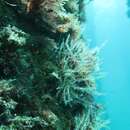Diagnosis
provided by World Register of Marine Species
Colonies stolonal or erect, arising from creeping hydrorhiza; hydrocauli monosiphonic or polysiphonic; hydrothecae shallow to bell-shaped, sessile or pedicellate, basal region with delicate diaphragm, with or without desmocytes; hydranths usually much larger than hydrothecae, with or without an intertentacular web. Nematophores present, with variably reduced nematothecae. Gonophores fixed sporosacs; gonothecae solitary or aggregated to form a glomulus
Choong H., Calder D., Chapman J., Miller J., Geller J., Carlton J. (2018). Hydroids (Cnidaria: Hydrozoa: Leptothecata and Limnomedusae) on 2011 Japanese tsunami marine debris landing in North America and Hawai‘i, with revisory notes on Hydrodendron Hincks, 1874 and a diagnosis of Plumaleciidae, new family. Aquatic Invasions. 13(1): 43-70.
- license
- cc-by-4.0
- copyright
- WoRMS Editorial Board
Diagnosis
provided by World Register of Marine Species
Colonies stolonal or erect, arising from creeping hydrorhiza; hydrocauli monosiphonic or polysiphonic; hydrothecae shallow to bell-shaped, sessile or pedicellate, basal region with delicate diaphragm, with or without desmocytes; hydranths usually much larger than hydrothecae, with or without an intertentacular web. Nematophores present, with variably reduced nematothecae. Gonophores fixed sporosacs; gonothecae solitary or aggregated to form a glomulus
Choong H., Calder D., Chapman J., Miller J., Geller J., Carlton J. (2018). Hydroids (Cnidaria: Hydrozoa: Leptothecata and Limnomedusae) on 2011 Japanese tsunami marine debris landing in North America and Hawai‘i, with revisory notes on Hydrodendron Hincks, 1874 and a diagnosis of Plumaleciidae, new family. Aquatic Invasions. 13(1): 43-70.
- license
- cc-by-4.0
- copyright
- WoRMS Editorial Board
Status
provided by World Register of Marine Species
The validity of the taxon as well as its systematic position needs to be confirmed by genetic analyses. Some members could also belong to the Zygophylacidae
Schuchert, P.
- license
- cc-by-4.0
- copyright
- WoRMS Editorial Board

